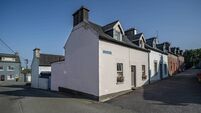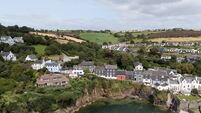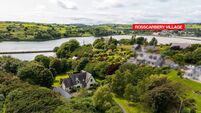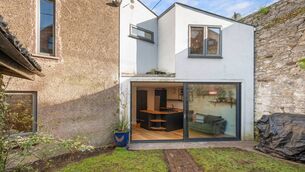Home with a heart is heaven sent

WHEN The Old Rectory, on Cork’s Blackrock Road, last changed hands some 27 years ago, its sale at auction made the news pages of this paper. We billed the six-figure sum achieved as the most expensive house ever sold in the southern ‘capital.’
Then, back in the depressed mid-’80s, the fortunate purchasers went and put the same amount of money again as they’d spent in acquiring the Rectory into its upgrades. They put in a kitchen, several bedroom en suite bathrooms, heated it, laid out its gardens to the gracious standard they now are, and generally treated it all with due respect and design deference, whilst making it suitable for a new generation, with higher expectations of comfort.
Fully red-brick on the outside, the 1878-built house has a feel of some of Dublin’s best D4 and D6 homes, the likes of an Aylesbury or Shrewsbury Road pile, but in Cork terms, houses of this quality are extremely rare — hence their prized-stakes value.
Had it come up for re-sale in the mid-2000s, in the height of the boom, there’s little doubt that it would again have achieved a record price, or something close to it. After all, local reports have it that a particular new-build not more than a few hundred yards away on the Blackrock Road could have cost as much as €6m to build, and, at the city end of the Blackrock Road, a period Georgian villa had a massive upgrade and extension, which also may have come close to a €6m spend.
So, into this exalted company comes the Old Rectory, a genuine prize once more at the city market’s upper end — and it carries an asking price today of €2.2m.
It’s a market-savvy price, not cheap, but cheap enough for what it is, and whoever buys it is likely to spend decades here enjoying its every aspect (though, to be honest, if and when the world recovers from its economic woes, it will rise again in value. Surely.)
On 1.7 acres of suburban idyll next to Menloe Gardens, within an amble of Blackrock village and the Marina, it’s a 3,800 sq ft immaculate period Victorian home, designed by the celebrated Cork architect William Henry Hill, who had an extensive private practice and who was the Church of Ireland’s Cork, Cloyne and Ross diocesan architect in the 1870s. His sizeable building output was marked by design quality and integrity, and included church renovations and institutional buildings as well as private homes. He designed similar rectories in Cork, at Douglas and Glanmire, and the latter’s considered a virtual twin to Blackrock’s rectory.
Built as the Glebe House for the clergy of genteel Blackrock village and St Michael’s Church on nearby Church Road, it served that role for just over a century and left C of I ownership in the 1980s, when it found its current owners.
It’s been extremely well-kept throughout their tenure and the gardens (which had been familiar to generations for fetes) have been brought on considerably, following expert planting and landscape advice from the likes of Verney Naylor and Brian Cross. Trees include a Japanese flowering crabapple (Malus Floribunda), some notable acers and yews, and some more recent yew creating a horseshoe shape feature by a sundial, a tulip tree and a Judas tree, and currently the garden’s autumnal shades are sublime, front, back and sides.
Given there’s so much grounds, the lower portion has been screened off behind a high hedge and arch for a very productive orchard plus organic fruit and vegetable garden; it has enough asparagus harvested each year to supply several restaurants, while the family’s freezers fill up annually with raspberries and other soft fruits.
Selling agents Sheila O’Flynn and Ann O’Mahony of Sherry FitzGerald position its era as mid-Victorian, and as such is one of the more recent period arrivals on this classic stretch of leafy suburbia, with older Georgian homes and villas dotted along the Blackrock Road, and along Castle Road too.
They rightly single out the balancing act it manages between being graceful, elegant and large, but avoiding vulgarity and bling: a rector, vicar or canon’s wife might be envious of the comfort levels and finery, but they couldn’t dismiss it as inappropriate.
For those today with the money to have the Old Rectory within their grasp, it will make an ideal family home for decades to come, and a good, lively clan will make the very most of its attributes, inside and out. It’s not so big that rooms will lie idle, and even the balance of fine formal rooms and more intimate ones and the flow between them works well for modern living. The only real change made in recent years was the south-facing garden room, off the warm kitchen/breakfast room, and even that’s a paragon of good taste (though a more Victorian design and glass roof might have suited the exterior design more sympathetically.)
There are five ground floor rooms in all. First up and best dressed is the formal drawing room with arching, bay window, for garden views. This bay has three sash windows, each slightly curved as is the glass, and windows throughout the house seem to be original, well maintained and painted. This 24’ by 20’ wall-papered and window-draped room has a double aspect, with fine marble fireplace, has 10’ high ceilings and understated decorative plasterwork.
There’s a family living room across the hall (once admiring the stained glass door and porch with original Victorian tiled floor with the house’s 1878 date inset in it,) a formal dining room looks out towards the house’s front entrance and approach avenue, with limestone pillars signalling its presence on the Blackrock Road by Menloe Gardens.
A reminder of earlier times here, too, is the presence of a small cubby entrance by the stairwell, where the housekeepers of the day would have received the delivery of goods from local, bicycle-borne messenger boys. Home deliveries today are more likely to be ordered on-line, and dispatched by van.
Since the servants were themselves dispatched, the kitchen has been relocated to a larger, sunnier and more prominent spot in the house, and really gets the benefit of the upgrade. In fact, the owners decided to raise part of the kitchen up onto a curving half-step plinth, as the ceiling height was so good. Units here are hand-painted, top-of-the scale ORM solid timber in the main, with a reconditioned two-oven Aga for warming comfort all year around.
Other rooms include a den/study, and the 17’ by 10’ sun room just off the kitchen as the part of the home that probably gets most use, with a second stairs, utility, boiler room and guest WC all off away to the far end of the graceful entrance hall and main stairwell.
Up those stairs and past the tall, arched return window, are four good bedrooms, two of which are very large and comfortable with good en suite bathrooms to boot. Two of the bedrooms, facing east, have a double aspect, and the master bedroom has four sash windows in all, with long garden views.
Off a short corridor is a fifth bedroom, walk-in hot-press, family bathroom and a separate WC.
The whole home is neat, appropriately attired and decorated, comfortable and surprisingly warm, thanks to a 1980s installed central heating system which functions efficiently via narrow pipes: when in use, the house is never cold, say the owners.
Sherry FitzGerald’s sales brochure chimes in with a description of the Old Rectory as “a home with a warm heart,” and with its current family reared and moving on from here (they’ve stories of football matches on the lawns) “now it’s the turn of a new family to feel this warmth and sense of home, it will no doubt continue to be cherished and loved well into the future” say the agents with what’s one of the very best sales instructions in the city in years.
At the guide of €2.2m, there’ll be more people wanting and wishing (and praying, too probably, given it’s a rectory) and then playing Euromillions Lotto, than can realistically hope to live here or could request a viewing with a clear conscience. But, there are some buyers out there, and Sherry FitzGerald have been active at this price level in the city where an Arts and Crafts house they offered in May at over €2m on stunning gardens may be close to a deal, at a sub-€2m sum.
The Old Rectory is the sort of quality trophy house that may well have buyers come back to Cork from overseas for, once word of its availability spreads.
VERDICT: What the Old Rectory would have made in the height of the boom is a moot point, back when new city records of €4 and €5m were set for established, private city homes.












